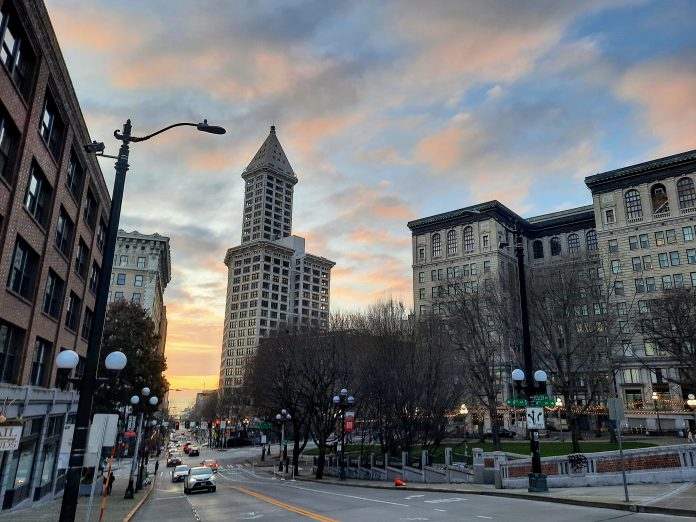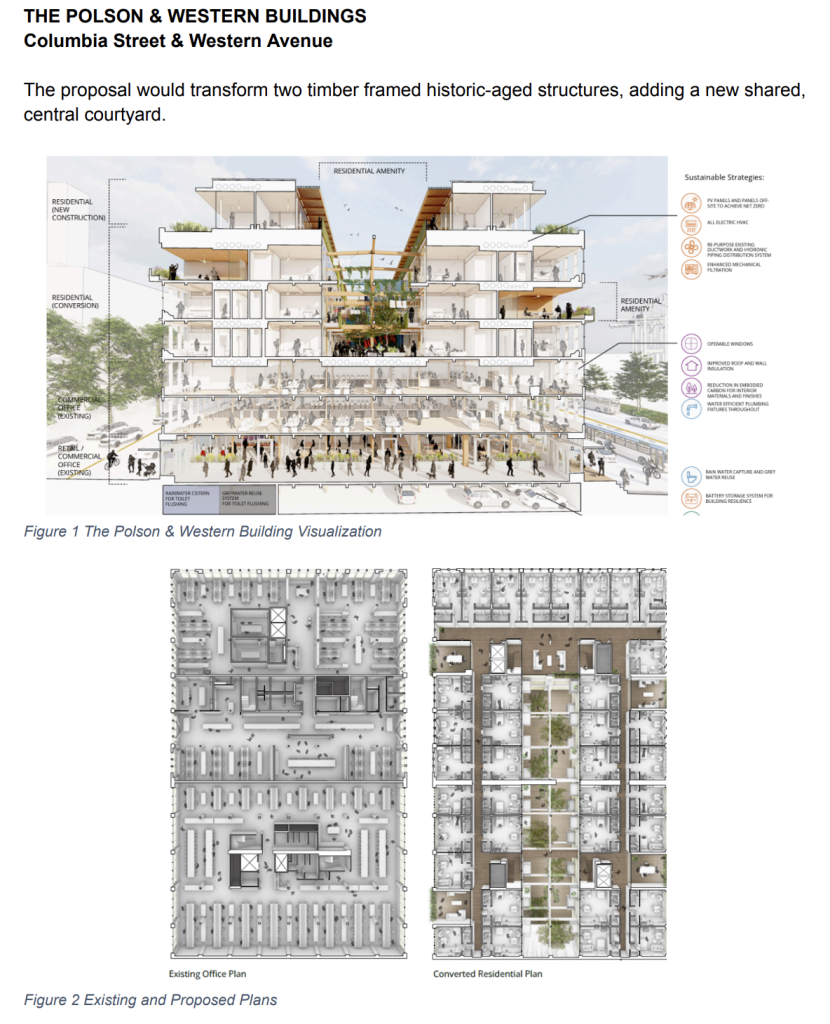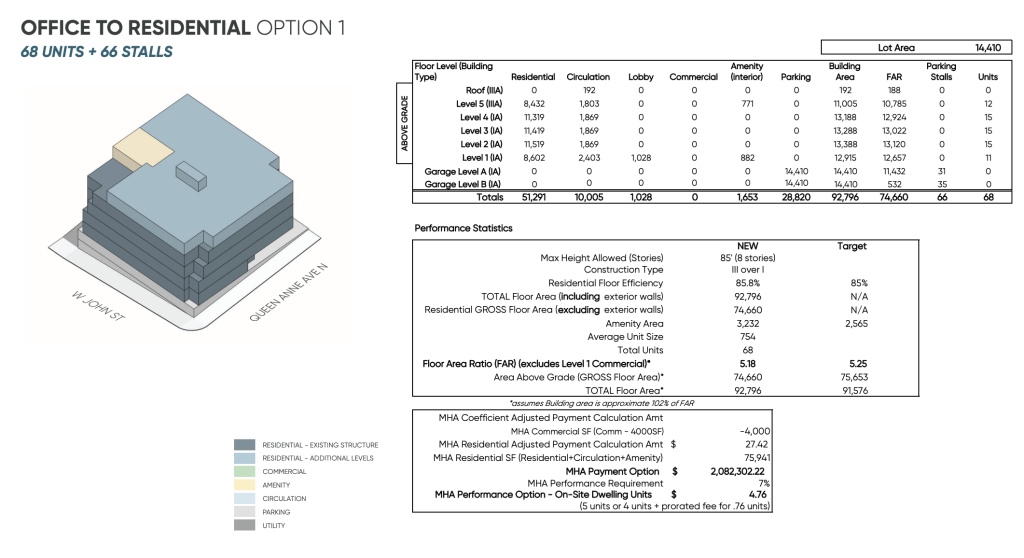
Seattle is considering legislation to support conversion of existing commercial buildings to residential. On Thursday, Mayor Bruce Harrell made the announcement in an effort to facilitate reuse of vacant commercial properties and fulfill a plank of his Downtown Activation Plan.
Downtown office vacancy rates exceed 20% as white collar workers opt to work from home and major employers downsize their office portfolios. Occupancy rates are closer to 50%, the Downtown Seattle Association reports, as some leased offices sit empty.
“With the recent passage of the State’s sales tax exemption on construction for projects converting nonresidential spaces to housing, this legislation is another powerful tool to tackle the housing crisis and replace building vacancies with vibrancy,” Harrell said in a prepared statement. “While we know there remains a need for office space, this effort will give us flexibility to help optimize our built environment and create the downtown we want to see — a thriving workplace and vibrant community for families and residents of all backgrounds. These changes are a critical step in moving the idea of office conversion to a reality.”
Urban theorists like Richard Florida have promoted the idea of office conversions in the pandemic era as a way to reinvigorate downtowns and grapple with high office vacancy rates and “downtown disorder.” Florida made this the theme of the keynote speech at the Downtown Seattle Association’s March 2022 “state of downtown” gala.
Mayor Harrell has been talking up the idea of converting under-occupied Downtown offices to housing since his 2023 “state of the city” address. In spring 2023, the City ran a design competition to generate excitement around the idea, but no projects have yet broken ground. The mayor’s incentives package hopes to spur building owners into action.
Harrell’s legislation would make changes to the City’s land use code to encourage office-to-residential conversions and addition of residential uses to existing buildings. Conversion of existing structures in these cases would be afforded broad exemptions from development standards, design review, and the City’s Mandatory Housing Affordability (MHA) program which requires contributions for affordable housing. These changes would apply across the city where non-residential structures exist and multifamily residential uses are permitted, including in all Downtown zones as well as all Commercial, Neighborhood Commercial, Seattle Mixed, Midrise, and Highrise zones.
For the purposes of determining what an existing building is, the proposed legislation would allow for conversion of any building where a temporary or permanent certificate of occupancy has been issued as of March 1, 2024, or otherwise has been determined to have been legally occupied by that date. The proposed legislation would also offer a path for planned buildings with unexpired Master Use Permits issued on or before March 1, 2024 to qualify as existing, though fewer exemptions may apply.
Under state law passed last year, Seattle is obliged to remove barriers to conversion of commercial buildings to residential uses before July 2025. That includes generally waiving away parking mandates, setbacks, floor area ratio, density limits, and exterior design and architectural requirements. Harrell’s proposed legislation would do that and more and even allow some minor vertical and horizontal expansions of structures to accommodate new residential uses.
According to an analysis by the Office of Planning and Community Development in January, the proposed legislation could deliver 1,000 to 2,000 homes in the next seven years, spread across a dozen or fewer projects. That’s a drop in the bucket for needed housing in the city, but could give a jolt of economic vitality in areas seeing a decline of office workers.
“I think every little bit helps,” Jon Scholes, CEO of the Downtown Seattle Association, told The Urbanist. “And, there’s some legislation at the federal level to provide federal tax credit for [office] conversion. And then, local, state other programs, so you get a capital stack that starts to make sense, and it then becomes economically feasible.”
Not all office buildings are readily adaptable to residential use due to their layout (large floorplates mean not much natural light in the core) and the need to add plumbing and other amenities, which can be costly. Hence not all underused office buildings are automatically a fit for conversion, and it tends to be the older buildings that are more of fit.
The land use changes that Harrell is proposing would be complemented by current environmental review exemptions that apply to housing development. Last year, changes to state law fully eliminated red tape traditionally required by the State Environmental Policy Act when converting to residential uses, at least through September 2025.
State legislation passed this year will also offer an added incentive for conversions, if approved by the Seattle City Council.
Senate Bill 6175 provides a local option to cities like Seattle to approve a sales tax deferral for conversion of underutilized commercial buildings. Qualifying projects would need to be mainly for multifamily housing and rent or sell at least 10% of units as affordable to low-income households, and meet any other requirements that a local jurisdiction sets. Projects that maintain properties for qualifying purposes under the tax deferral program for at least 10 years wouldn’t need to repay any deferred sales tax.
In addition, qualifying projects could be eligible for participation in a local Multi-Family Tax Exemption (MFTE) program, which is due for an update based on recent state legislation.
Councilmember Tammy Morales (District 2), who chairs the City Council’s land use committee expressed support for the mayor’s legislation.
“We must pursue every opportunity to build vibrant neighborhoods and increase housing throughout our city,” Morales said. “This is particularly true of downtown. I am excited to work toward making our downtown affordable to more families and workers and look forward to reviewing this legislation in my land use committee.”
However, she also has expressed reservations about the mayor’s proposal to exempt office conversions from MHA fees.
“Not using the MHA tool would be a missed opportunity to leverage funding to build affordable housing that we can’t immediately replace,” Morales told The Seattle Times. “If the housing to be built downtown is market rate, then it should help pay for affordable housing elsewhere — or even downtown.”
Councilmember Bob Kettle (District 7), who represents most of downtown, also said he supported the legislation along with several individuals representing development interests.
“With these proposed changes, the Executive has created an incentive which will, in turn, help to address a myriad of problems that all Seattleites have experienced: housing, public safety and economic viability being chief among them, and largely in the areas that need it most,” Kettle said.
Among development interests, Marc Angelillo from Stream Real Estate noted that his company is actively working on an office-to-residential conversion, hoping to be one of the first. His company plans to turn a shuttered five-story office building in Uptown into 68 homes. Known as Queen Anne Plaza, the building is located at 201 Queen Anne Avenue N and has about 52,000 square feet of floor area on a site measuring 120 feet by 120 feet. Preliminary costs for the conversion is estimated at about $12 million.
Whether many conversion projects follow in the footsteps of Queen Anne Plaza remains to be seen. Even with incentives, they make for complicated projects.
Doug Trumm is publisher of The Urbanist. An Urbanist writer since 2015, he dreams of pedestrian streets, bus lanes, and a mass-timber building spree to end our housing crisis. He graduated from the Evans School of Public Policy and Governance at the University of Washington in 2019. He lives in Seattle's Fremont neighborhood and loves to explore the city by foot and by bike.



